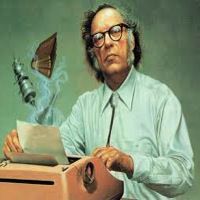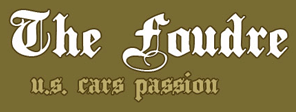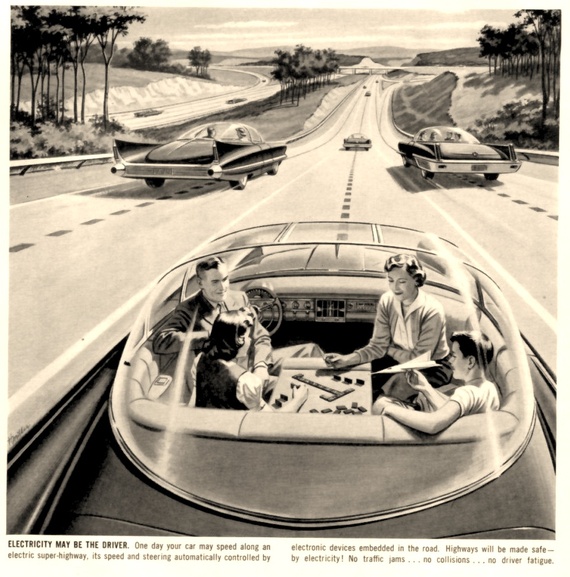
In 1964, Isaac Asimov Imagined the World in 2014 ...
1 /
Published on 09.15.2013  |
 |
 |
|
The New York World's Fair of 1964 is dedicated to "Peace Through Understanding." Its glimpses of the world of tomorrow rule out thermonuclear warfare. And why not? If a thermonuclear war takes place, the future will not be worth discussing. So let the missiles slumber eternally on their pads and let us observe what may come in the nonatomized world of the future.
What is to come, through the fair's eyes at least, is wonderful. The direction in which man is traveling is viewed with buoyant hope, nowhere more so than at the General Electric pavilion. There the audience whirls through four scenes, each populated by cheerful, lifelike dummies that move and talk with a facility that, inside of a minute and a half, convinces you they are alive.The scenes, set in or about 1900, 1920, 1940 and 1960, show the advances of electrical appliances and the changes they are bringing to living. I enjoyed it hugely and only regretted that they had not carried the scenes into the future. What will life be like, say, in 2014 A.D., 50 years from now? What will the World's Fair of 2014 be like?
I don't know, but I can guess.
One thought that occurs to me is that men will continue to withdraw from nature in order to create an environment that will suit them
better. By 2014, electroluminescent panels will be in common use. Ceilings and walls will glow softly, and in a variety of colors that will change at the touch of a push button. Windows need be no more than an archaic touch, and even when present will be polarized to block out the harsh sunlight. The degree of opacity of the glass may even be made to alter automatically in accordance with the intensity of the light falling upon it.
Robots will neither be common nor very good in 2014, but they will be in existence. The I.B.M. exhibit at the present fair has no robots but it is dedicated to computers, which are shown in all their amazing complexity, notably in the task of translating Russian into English. If machines are that smart today, what may not be in the works 50 years hence? It will be such computers, much miniaturized, that will serve as the "brains" of robots. In fact, the I.B.M. building at the 2014 World's Fair may have, as one of its prime exhibits, a robot housemaid*large, clumsy, slow- moving but capable of general picking-up, arranging, cleaning and manipulation of various appliances. It will undoubtedly amuse the fairgoers to scatter debris over the floor in order to see the robot lumberingly remove it and classify it into "throw away" and "set aside." (Robots for gardening work will also have made their appearance.)
General Electric at the 2014 World's Fair will be showing 3-D movies of its "Robot of the Future," neat and streamlined, its cleaning appliances built in and performing all tasks briskly. (There will be a three-hour wait in line to see the film, for some things never change.)
The appliances of 2014 will have no electric cords, of course, for they will be powered by long- lived batteries running on radioisotopes. The isotopes will not be expensive for they will be by- products of the fission-power plants which, by 2014, will be supplying well over half the power needs of humanity. But once the isotype batteries are used up they will be disposed of only through authorized agents of the manufacturer.
And experimental fusion-power plant or two will already exist in 2014. (Even today, a small but genuine fusion explosion is demonstrated at frequent intervals in the G.E. exhibit at the 1964 fair.) Large solar-power stations will also be in operation in a number of desert and semi-desert areas -- Arizona, the Negev, Kazakhstan. In the more crowded, but cloudy and smoggy areas, solar power will be less practical. An exhibit at the 2014 fair will show models of power stations in space, collecting sunlight by means of huge parabolic focusing devices and radiating the energy thus collected down to earth.
The world of 50 years hence will have shrunk further. At the 1964 fair, the G.M. exhibit depicts, among other things, "road-building factories" in the tropics and, closer to home, crowded highways along which long buses move on special central lanes. There is every likelihood that highways at least in the more advanced sections of the world*will have passed their peak in 2014; there will be increasing emphasis on transportation that makes the least possible contact with the surface. There will be aircraft, of course, but even ground travel will increasingly take to the air*a foot or two off the ground. Visitors to the 1964 fair can travel there in an "aquafoil," which lifts itself on four stilts and skims over the water with a minimum of friction. This is surely a stop-gap. By 2014 the four stilts will have been replaced by four jets of compressed air so that the vehicle will make no contact with either liquid or solid surfaces.
Jets of compressed air will also lift land vehicles off the highways, which, among other things, will minimize paving problems. Smooth earth or level lawns will do as well as pavements. Bridges will also be of less importance, since cars will be capable of crossing water on their jets, though local ordinances will discourage the practice.
Much effort will be put into the designing of vehicles with "Robot-brains"*vehicles that can be set for particular destinations and that will then proceed there without interference by the slow reflexes of a human driver. I suspect one of the major attractions of the 2014 fair will be rides on small roboticized cars which will maneuver in crowds at the two-foot level, neatly and automatically avoiding each other.
For short-range travel, moving sidewalks (with benches on either side, standing room in the center) will be making their appearance in downtown sections. They will be raised above the traffic. Traffic will continue (on several levels in some places) only because all parking will be off-street and because at least 80 per cent of truck deliveries will be to certain fixed centers at the city's rim. Compressed air tubes will carry goods and materials over local stretches, and the switching devices that will place specific shipments in specific destinations will be one of the city's marvels.
Communications will become sight-sound and you will
Article : By Isaac Usinov published in The New York Times,
Denis Eveillard
Article précédent : 2013 The Louisville Concours d'Elegance ... |
Article suivant : September 2013, News American Classic Drive ... |


